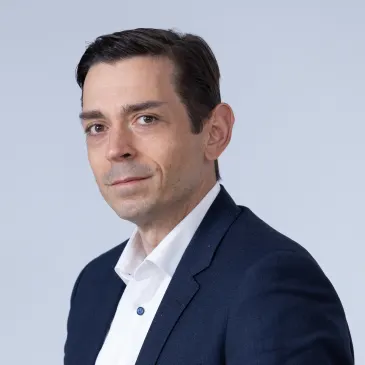The following content is a transcript from our interview series with Jat Brainch, former Chief Commercial and Digital Officer of Inmarsat, and Andrej Danis, Partner & Managing Director, North America Telecommunications Lead at AlixPartners. Learn more about AlixPartners' approach to the telecommunications industry here.
The Lean, Mean, Green approach to operations
Andrej: We created a concept at AlixPartners for operators—and for the whole industry—around “lean, mean, green” telco, because operators today are struggling. The logic is to get “lean” to crush the skeleton, the old framework which is holding them back. Then, our concept explains how operators can get “mean” to get back on attack and proactively go for market opportunities, and get “green” to operator more effectively, attract talent, and really do better for our future.
Jat: I love the model—I think it's one of the greatest expressions of how we've got this big opportunity sitting in front of the global telecommunications business. One of the biggest challenges is that this is a high-capex environment, there's a huge amount of upfront investment that's required to keep people connected, which is the backbone of all the opportunities in the ecosystem. The challenge that comes with the need to raise capital is that you tend to rely on the same traditional KPIs that all telecommunications players have pointed to for a number of years to demonstrate that they're creating value that's worth investing in.
Now, for those who've been in the sector for decades, that can be quite challenging because the ecosystems that they developed 20-30 years ago are basically that skeleton that you talked about—that old operating model which is no longer fit for today because it was serving a market that used to be way more complicated.
Unless these operators take away that complexity, and start digitally thinking differently about how they interact with their customers, how they run their networks, how they use advanced innovations like AI and machine learning—costs will continue to erode their margins, while revenues will stay flat. Because the revenues that are growing are the ones that are now using advanced technologies, such as industrial IoT, connecting remote assets in order to generate more efficient ways of running businesses. That skeleton, if it's not set aside—however challenging it may be to do so—will continue to absorb free cash flow, which will then limit the money that can be invested in new ecosystems.
The importance of reducing complexity
Andrej: At this moment, I really see the constraints they are facing. Going “lean” provides a structure for investors and management to “future-proof” operations. Reducing the old skeleton and investing in advanced technologies being inextricably linked to drive improvements to operations. The problem lies in the fact that while both of these efforts have a cost associated with them, only one – the latter – is driving increasing in an organization’s valuation.
Jat: I think this comes down to whether or not they're actually making a funding change along with a change in the optics. It's very difficult to save money, or raise debt, or generate new money in order to grow in the new markets that we see. However, if you don't, what essentially happens is you lose your ability to move flexibly and generate new solutions—from a capital freedom perspective, as well as not having the money to invest in new technology nor meet customers’ needs.
Andrej: It comes down to the fundamentals. I remember always hearing the business is so complex. The ongoing joke was, “Yes, I want to talk and have internet, it's so complex.” The operators really need to start the simplification journey thinking about the customer they want to target and what product and marketing strategy will best connect with that customer. Once that is addressed, all of this legacy complexity becomes obsolete.
Jat: I think one of the challenges for the legacy operators is that the analysts, the investors, they need to understand the business in order to feel that they can invest with confidence. However, if you keep looking back at the way we've always done things, you're getting insight that says the customers need cases and use cases have changed. You have this dichotomy where you're trying to serve two very different types of needs, but only one is growing, only one is where the future opportunities are.
If you don't cut off the historic challenges and legacies that are still dragging in cost complexity and making customers’ lives difficult, you run the risk of trying to preserve the past, at the expense of investing in the future. Now the key here is to try and make sure that you're getting the best out of both worlds. If you understand enough about your customers, you must your proposition much simpler, much easier for them to decide.
The consumers or businesses that you're selling to, they're not paying for you to run a legacy system that has huge amounts of complexity they no longer value. They wouldn't feel great if they understood that you were spending money on these elements, because they’ll assume that will have an impact on the price they pay. And it can absolutely have an impact on price, but it also deflects money away from investing in the things that your end users do value.
Key growth factors for telcos
Andrej: If we think about going back on the attack and getting “mean,” what should operators do? What do you see as the key growth factors for them to address?
Jat: Once they've addressed their cost base, and the legacy framework that's holding them back, I see two main opportunities. One is that they have a huge amount of data and insight into the end customers, the businesses they're serving, gained by how the network operates. They know how people use their connectivity, when they use it, how often they use it, where they use it. Now that data tends to sit within operators and doesn't get used a lot; people are worried about data protection and have concerns about privacy. However, there is a huge amount you can do with that data, even by anonymizing it, given the massive customer bases these operators have.
With customers now opting in to make their data more available—most of us on social media or using online news resources click away our cookie rights—this trend should drive more value back to operators. It’s a fair value exchange, letting companies collect our data in return for more relevant content or ads, and is becoming more and more prevalent. Again, operators have this responsibility to act with care and diligence around data, but where they generate a huge amount of trust is around how they run their networks, how they effectively and securely look after customer systems and data. If they can prove this to customers, they can further build trust by saying “look at how we currently operate, in a way that works for you and for us.”
The second area is partnerships. One of the biggest opportunities that operators have is to not try to be all things themselves. Instead, they should partner with others to provide that complete, ubiquitous connectivity service globally. Working in their favor here is that at the moment, the technology is making that easier and easier.
Winning talent & making green profitable
Andrej: An interesting factor you told me about when we last spoke was that to do the above, you need to attract top talent, which currently tends to end up at tech companies, cloud companies, and so on. The “green” aspect also comes into play here—I remember you mentioning junior employees were horrified when they saw plastic utensils in your canteen.
Jat: Absolutely. Talent is one of the keys here because the market is moving so quickly. People are understanding what the possibilities are, and they're endless. If I think about ESG, there are people doing things to make greener, leaner policies come to life across multiple sectors. What operators can do is actually make it easier for that ecosystem to thrive and grow. All of these solutions rely on connectivity—they need ubiquitous, seamless, reliable, secure connectivity. Operators can either try to own that whole value chain, and attract all that talent, or they can work in partnership with others where this talent is already growing and being nurtured.
In terms of talent in general, people will go to the companies where they know they're going to get investment and freedom to operate. Clearly, a telco operator is going to have to do something different to try to attract that talent against the rest of the market.
Andrej: The perception in the market is that if you want to be green, it costs money. However, you fundamentally disagree with this message.
Jat: I think when people say it costs money, they're worried that it depletes profit, and I do fundamentally disagree with that. I think it's really important to be environmentally friendly, from a cost management perspective but also to grow revenues. There are huge amounts of evidence now that say the importance of being a green, reliable, sustainable organization cuts through in terms of gaining market share and being credible with consumers and businesses you want to work with. You wouldn't see such growth from B Corp organizations if that wasn't true.
Equally, though, some organizations want to be green because otherwise they’re going to get fined. But I find the first reasons more compelling and more interesting. The number of companies that are improving their commercial performance—i.e., generating greater margins by being green—keeps growing. For example, we work with agricultural companies in my current role, who are having to monitor their crop yields. Crop yields are a major concern across the planet at the moment; the UN estimates that we're going to have to increase the crop yield globally by three-fold over the next 10-30 years if we're going to feed the population. Now, the instant answer to that is cut down more rainforests and other areas, which would not be great for the sustainability of the planet.
But what if you can actually just improve the yield of your existing crops? Using industrial IOT and connectivity, you can monitor remote assets and remote farms for crop health, for watering levels, for the need to rotate crops in a different way—all from a device that's hundreds of miles away using satellite connectivity. The beauty of that is it not only drives down the cost to maintain those crops, but because you can then use AI and machine learning to remotely switch on irrigation systems or change the composition of crop-feeding machines and so forth, you can improve your yield and revenue you generate while can generate while lowering costs. It's a win-win.

